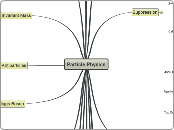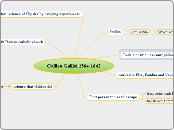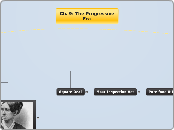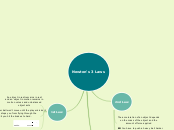Particle Physics
Supersymmetry (SUSY)
SUSY fixes two problems with GUTS
Lifetime of the proton is extended to a just acceptable level of 10^33 years
All the forces meet at the same point in SUSY, unlike in GUTS
Every particle has a supersymmetric other half
bosons go to bosinos
leptons go to sleptons
quarks go to squarks
Grand Unified Theories
Predicted to produce X and Y bosons
Y has charge -1/3
X has charge -4/3
Combining Strong, EM and Weak Interactions into one Force
Matter-Antimatter Asymmetry
However, CP violation effects are too small to account for this entirely at the present time.
If this happens for 1 quark per 1 billion, then explains the matter dominated universe
If there is CP violation, then one process can be more favourable than the other
Then also u u > dbar e+
So Assumed d e- > ubar ubar
Lets look at decay of the X particle
Xbar -> u u OR dbar e+
X -> ubar u bar OR d e-
Number of Generations
3 Generations of Particle
Assume different amounts of flavours and neutrinos and assume lepton universality. Then see which line fits best (see lectures for details and a nice picture)
Determined by LEP by looking at cross sections of Z0 decay
Lepton Universality
In a given decay process of W or Z, quarks are 3 times more like to be produced than leptons due to colour
In a given reaction for which mass is irrelevant, e, mu and tau all act in the same way. Same applies for neutrinos
CP Violation
It is however violated in, for example, a K0 beam
There is mixing, so that what starts of as pure K0 ends up as a mixture of both K0 and anti K0. This violates CP (handwavey, I know)
But the combined CP action is not violated
C and P are individually violated by trying to perform the actions on neutrinos
Higgs Boson
Higgs Bosons has mass, and is being looked for by detectors
Or the interesting Lecturer!
Analogous to the Muddy Field
Bosons should be massless, but they are not (W & Z)
Antiparticles
Every particle has an antiparticle
Has all the properties of normal particles, with all arithmetically additive quantum numbers
Can be thought of as a positive energy particle going backwards in time
Comes from the -ve part of E^2 = m^2 + p^2
Invariant Mass
Invariant Mass doesn't change in any inertial frame
Use this for any kind of collision so that we can set the momentum to zero
M^2 = (Sum of all E)^2 - (Sum of all P)^2
Helicity
Antineutrinos are always right handed
Neutrinos are always left handed (due to effectively moving at the speed of light)
Spin parallel to motion is Right Handed
Describes direction of spin angular momentum relative to motion
Quarks
Colour
Evidence for Colour
Ratio of cross section of hadrons to cross section of muons in e+e- annihilation is 3x larger than expected
Particle decay rates are 3x faster than expected for quarks
Allows hadrons like sss
Asymptotic Freedom
The closer 2 quarks are to each other, the less they are bound by gluons
Confinement
Becase Gluons can self interact, the further out a quark is, the strong it is attrated to its neighbour
Gluon has colour-anticolour
Force Carrier is the Gluon
6 Colours, R, G, B and anti colours
Evidence for Quarks
Scattering
Scattering of nucleus by various sources and interactions all found that they scattered off particles of fractional charge
Cross sections
The ratio of the cross sections is 2:3
p p collisions have a cross section of 40 mb, and a ratio of 3 quarks to 3 quarks
Pi+ p collisions have a cross section of 26 mb, and a ratio of 2 quarks hitting 3 quarks
Top Quark
Mass of 172 GeV
Doesn't form hadrons, decays too fast
Detected in 1994 by CDF at Tevatron
Mass was predicted at LEP using virtual t tbar loop
Predicted because something had to go with the b quark
Upsilon Particle
Consists of b bbar, quark model now has 5 base quarks
J/Psi Particle
Detected independantly by Richter and Ting
Longer than usual strong decay lifetime due to Zweig suppressed decay
Was first evidence for something beyond 3 quark model
Consists of c cbar, so has 'hidden charm'
Suppression
Cabibo Suppression
Dictates that quarks don't tend to decay from the top-generation to the bottom-generation.
Not needed for this course
Zweig Suppression
Crossection is proportional to Coupling Constant ^ n for n/2 gluons
Because each vertex of a feynman diagram adds a power to the coupling constant, lowering brancing ratio
Even if the process with less gluons has a smaller Q value
A Process is Zweig Suppressed if it requires many gluons to do it
Resonance
Production
Used by Ting to find what he called the J Particle
Ting is Bad
Measure the Invariant Mass of all produced particles, should get a spike at resonance mass above the average mass of any 2 particles
Brute Force method, by plowing your beam into target with loads of energy
Formation
Used by Richter to find what he called the Psi Particle
Richter is Good
Will get a significant spike at the mass of the resonance particle due to its creation only happening when there is momentum conservation
Look for outcoming particles and measure their Centre of Mass Energy
Fire particles into a target at varying energies
Can be found by Formation or Production
It does not violate energy or quantum number violations
A Resonance is a particle that decays via the storng interaction
Conservation Laws
CP
This implies that particles and antiparticles have similar properties, quantum numbers aside
e.g. Spin should be the same etc.
e.g. Mass should be the same
This is conserved for weak (In almost all circumstances)
The action of both the Charge Conjugation and the Parity transformation on a particle
Charge Conjugation
It is conserved in Strong and EM, but not Weak
Charge Conjugation is a mutliplicative quantum number
Particles which are their own antiparticles, C^2 returns initial particle
Changes the charge of a particle
Parity
Parity is conserved in Strong and EM interactions, but not Weak
Particles have intrinsic parity of +/- 1
Parity is a multiplicative quantum number
Axial Vectors are unchanged
e.g. L = r x p -> -r x -p = L
Normal Vectors change sign
e.g. p -> -p
e.g. v -> -v
e.g. r -> -r
This transfers co-ordinates of a system
New
Quantum Numbers such as: B, S, I, C, L
These are not necessarily always conserved
Old
Charge
Momentum
Energy
Old Laws are always conserved
Supermultiplets
If we allow all quarks and L > 0 then it gets very complicated
For Mesons you get a 0- Nonet and a 1- Nonet
For baryons you get a 1/2+ Octet and a 3/2+ Decuplet
We Only consider L=0, so J = S. Assume only quarks are up down and strange
Interactions and Force Propogators
Electromagnetic
Photons are chargeless and massless
Interact with charge
Photons
Weak
Very Short Range
Interact with all particles
W and Z Bosons with approximately 80 and 90 GeV of Mass respectively
Z can be made in high energy annihilation, can decay to anything neutral
W Changes Flavour of quark
Strong
Has Colour itself, so is self interacting
Colour is normally a Colour-Anticolour pair, i.e. Red-Antigreen
Interacts with Colour
Gluons
Found by 'Fat Jets' as opposed to normal jets









